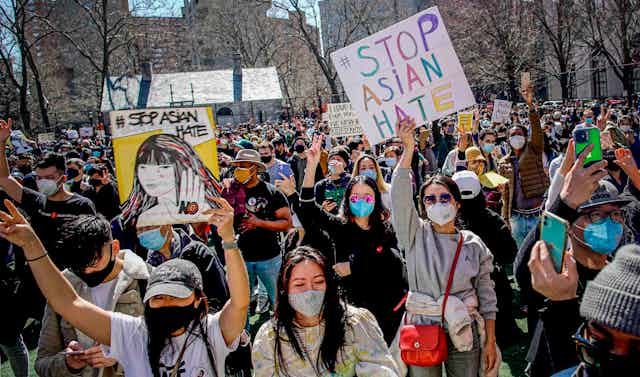Violence and pain change the way we experience our surroundings and the way our bodies move: our eyes become wide in search of potential dangers, our bodies become tense.
What is the power — both negative and positive — of understanding such violence and pain with numbers? There are dangers in reducing our pain to numbers, but at the same time, we can use mathematical literacy for social causes by revealing hidden violence, such as the violence against migrant racialized women.
Mathematical literacy doesn’t just mean mastering mathematics defined by school curriculum; it also means gaining a sense of how to apply mathematical concepts to everyday life, for social causes and gaining insight into how numbers and data have inherently political resonances. It can also provide us with the opportunity to listen to historically marginalized voices to analyze interlocking systems of violence and oppression.
Intersectionality and violence against women
The recent mass shooting in Atlanta that violently took the lives of eight people, six of which were Asian American women, sparked demonstrations against anti-Asian racism that have long been silenced through the model minority myth — which minimizes and undermines the experiences of racism among Asians.
Read more: The model minority myth hides the racist and sexist violence experienced by Asian women
The intersection of racism and sexism and other interlocking systems of oppression, like migration, geo-economic politics and the criminalization of sex work are considered to be at play in the violence that happened in Atlanta.
A lens of intersectionality shines light on the violence against Black women, Indigenous women and racialized women at large. And it also reveals the violence against Asian women who have been stereotypically hypersexualized and deemed submissive, disposable and consumable.
The power of mobilizing mathematical literacy
Understanding intersectional violence through numbers can help make visible the invisible.
In an era of protests, the political neutrality of mathematics is being questioned.

The power of mobilizing mathematical literacy for local policy changes became evident in my work with Virgie Aquino Ishihara, a longtime volunteer and community activist, at the Filipino Migrants Center, in Japan.
The Filipino Migrants Center worked tirelessly with migrant communities to redress violence rooted in human trafficking in the urban entertainment industry. It countered official data on domestic and work-place violence that did not reveal historically marginalized voices and violence against their bodies, through the numeration of hidden violence. Mobilization of mathematical literacy became a powerful tool in the context of social movements to redress human trafficking associated with entertainer visas.
By analyzing the economic impact of remittance from migrants in relation to governmental policies, the Filipino Migrants Centre was able to contextualize what pushed women to migrate as entertainer visa holders. These big-picture understandings led the activists to see historical and macro-economic dilemmas around domestic and workplace violence against migrant women — something that has been historically construed as personal problems.
Dangers in putting numbers to our pain
When violence against racialized women’s bodies is reduced to a number (“one” incident), and discussed simply as one more violent act against an anonymous racialized woman, elements and stories that women embody begin to be erased.
In this light, movements such as #SayHerName are important in centring stories of Black women who have been victimized by racially charged police violence from becoming a number (as seen in the recent killing of Breonna Taylor). Journalist, Shiori Ito, who led Japan’s social movement to fight against sexual violence chose to de-anonymize herself in order to challenge media that reports and speaks for these “numbers” whose stories and bodies end up erased through anonymity.

Such politics of de-anonymization, however, should also respect the choice of silence. To stay silent and to endure the hardships toward dignity — a notion captured by the Japanese term shinbo — was a choice made by some Japanese Canadians and Japanese Americans who experienced internment during the Second World War.
Numeration can also risk reducing our intersectional histories and experiences to deterministic categories. Binary and categorical frameworks (e.g. women versus men) inscribed in statistics can perpetuate genderism and queerphobia that privileges those who can conform to gender norms, cisnormativity and heteronormativity.
The complexities of human stories and the voices that deviate from the norm shouldn’t be lost in the process of numeration and mathematization.
Healing our collective pain
In our study, the Filipino Migrants Centre’s efforts to make visible the invisible by exercising mathematical literacy brought consequential changes in the urban entertainment district.
As we walked around the district, we noticed significant changes that took place in the public park — migrant women and allies came together. And as people came together, resident-led safety efforts developed as an alternative to institutional policing and surveillance. Creating a safer outdoor place required changing the actions of bystanders who can intervene in violence.
Mathematical literacy can allow us to listen to historically marginalized voices that are less heard yet powerful and strong to analyze interlocking systems of violence and oppression. However, numeration and mathematization have to be done through a non-hierarchical distribution of power with people who are directly impacted by historical oppression with respect to pain that cannot be reduced to numbers.
Intentional design of spaces toward solidarity, backed up with ethical mobilization of mathematical literacy, could move us toward healing our collective pain of violence.

